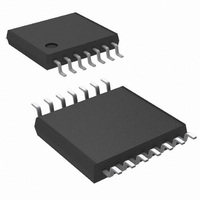LMP2234AMT/NOPB National Semiconductor, LMP2234AMT/NOPB Datasheet - Page 16

LMP2234AMT/NOPB
Manufacturer Part Number
LMP2234AMT/NOPB
Description
IC AMP PREC QUAD LO PWR 14TSSOP
Manufacturer
National Semiconductor
Series
LMP®, PowerWise®r
Datasheet
1.LMP2234BMTNOPB.pdf
(20 pages)
Specifications of LMP2234AMT/NOPB
Amplifier Type
General Purpose
Number Of Circuits
4
Output Type
Rail-to-Rail
Slew Rate
0.058 V/µs
Gain Bandwidth Product
130kHz
Current - Input Bias
0.02pA
Voltage - Input Offset
10µV
Current - Supply
36µA
Current - Output / Channel
30mA
Voltage - Supply, Single/dual (±)
1.6 V ~ 5.5 V
Operating Temperature
-40°C ~ 125°C
Mounting Type
Surface Mount
Package / Case
14-TSSOP
Lead Free Status / RoHS Status
Lead free / RoHS Compliant
-3db Bandwidth
-
Other names
*LMP2234AMT
*LMP2234AMT/NOPB
LMP2234AMT
*LMP2234AMT/NOPB
LMP2234AMT
Available stocks
Company
Part Number
Manufacturer
Quantity
Price
Company:
Part Number:
LMP2234AMT/NOPB
Manufacturer:
NS
Quantity:
3 062
www.national.com
Figure 2 shows a schematic of this input voltage noise reduc-
tion circuit using the LMP2234. Typical resistor values are:
R
PRECISION INSTRUMENTATION AMPLIFIER
Measurement of very small signals with an amplifier requires
close attention to the input impedance of the amplifier, the
gain of the signal on the inputs, and the gain on each input of
the amplifier. This is because the difference of the input signal
on the two inputs is of interest and the common signal is con-
sidered noise. A classic circuit implementation that is used is
an instrumentation amplifier. Instrumentation amplifiers have
a finite, accurate, and stable gain. They also have extremely
high input impedances and very low output impedances. Fi-
nally they have an extremely high CMRR so that the amplifier
can only respond to the differential signal. A typical instru-
mentation amplifier is shown in Figure 3.
G
= 10Ω, R
FIGURE 2. Noise Reduction Circuit
F
= 1 kΩ, and R
O
= 1 kΩ.
20203446
16
There are two stages in this amplifier. The last stage, the out-
put stage, is a differential amplifier. In an ideal case the two
amplifiers of the first stage, the input stage, would be config-
ured as buffers to isolate the inputs. However they cannot be
connected as followers because of mismatch in amplifiers.
That is why there is a balancing resistor between the two. The
product of the two stages of gain will give the gain of the in-
strumentation amplifier. Ideally, the CMRR should be infinite.
However the output stage has a small non-zero common
mode gain which results from resistor mismatch.
In the input stage of the circuit, current is the same across all
resistors. This is due to the high input impedance and low
input bias current of the LMP2234.
By Ohm’s Law:
However:
So we have:
Now looking at the output of the instrumentation amplifier:
Substituting from Equation 4:
This shows the gain of the instrumentation amplifier to be:
Typical values for this circuit can be obtained by
setting: a = 12 and K = 4. This results in an overall gain of
−100.
FIGURE 3. Instrumentation Amplifier
V
O1
–V
O2
= (2a+1)(V
−K(2a+1)
1
–V
2
)
20203436
(1)
(2)
(3)
(4)
(5)
(6)











